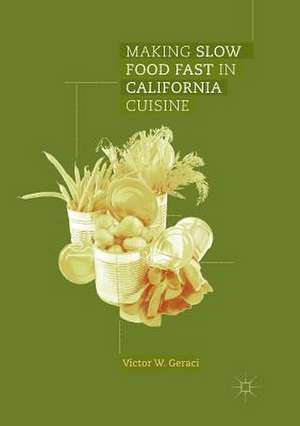Making Slow Food Fast in California Cuisine
Autor Victor W. Geracien Limba Engleză Paperback – 19 iul 2018
| Toate formatele și edițiile | Preț | Express |
|---|---|---|
| Paperback (1) | 579.52 lei 43-57 zile | |
| Springer International Publishing – 19 iul 2018 | 579.52 lei 43-57 zile | |
| Hardback (1) | 584.76 lei 43-57 zile | |
| Springer International Publishing – 10 mar 2017 | 584.76 lei 43-57 zile |
Preț: 579.52 lei
Preț vechi: 681.79 lei
-15% Nou
Puncte Express: 869
Preț estimativ în valută:
110.89€ • 116.09$ • 91.75£
110.89€ • 116.09$ • 91.75£
Carte tipărită la comandă
Livrare economică 07-21 aprilie
Preluare comenzi: 021 569.72.76
Specificații
ISBN-13: 9783319850023
ISBN-10: 3319850024
Pagini: 225
Ilustrații: XVI, 225 p.
Dimensiuni: 148 x 210 mm
Greutate: 0.3 kg
Ediția:Softcover reprint of the original 1st ed. 2017
Editura: Springer International Publishing
Colecția Palgrave Macmillan
Locul publicării:Cham, Switzerland
ISBN-10: 3319850024
Pagini: 225
Ilustrații: XVI, 225 p.
Dimensiuni: 148 x 210 mm
Greutate: 0.3 kg
Ediția:Softcover reprint of the original 1st ed. 2017
Editura: Springer International Publishing
Colecția Palgrave Macmillan
Locul publicării:Cham, Switzerland
Cuprins
Chapter 1: Introduction: A Context for California Cuisine.- Chapter 2: The Early California Larder and The Gold Rush Food Revolution.- Chapter 3: Climate, Land, Water, and Government Policies Establish California Agribusiness.- Chapter 4: Ingredients for the First California Cuisine.- Chapter 5: The Early Wine Industry; Establishing California Vintibusiness.- Chapter 6: Agribusiness Reigns in California.- Chapter 7: Laying the Foundation for California’s Industrial Food Model.- Chapter 8: Redesigning the Quest for Good Food in the Early Twentieth-Century.- Chapter 9: California Fast Food Cuisine.- Chapter 10: California Wine Rises to Stardom.- Chapter 11: Beginnings of A California Counter-Cuisine.- Chapter 12: Everyday Cooks Challenge Fast Industrial Foodways.- Chapter 13: Slow Food Pioneers Rebuild a California Cuisine.- Chapter 14: Bay Area Struggles To Defeat Fast Food.- Chapter 15: Epilogue: Shifting the Paradigm: Short Steps Towards Sustainability.
Notă biografică
Victor W. Geraci held positions as Associate Professor of History at Central Connecticut State University, USA and Associate Director of the University of California, Berkeley, USA’s Oral History Center. Geraci’s book publications include Salud!: The Story of the Santa Barbara Wine Industry, Icons of American Cooking, The Lure of the Forest: Oral Histories from the National Forests in California, and The Unmarked Trail: Managing National Forests in a Turbulent Era.
Textul de pe ultima copertă
This book follows the development of industrial agriculture in California and its influence on both regional and national eating habits. Early California politicians and entrepreneurs envisioned agriculture as a solution to the food needs of the expanding industrial nation. The state’s climate, geography, vast expanses of land, water, and immigrant workforce when coupled with university research and governmental assistance provided a model for agribusiness. In a short time, the San Francisco Bay Area became a hub for guaranteeing Americans access to a consistent quantity of quality foods. To this end, California agribusiness played a major role in national food policies and subsequently produced a bifurcated California Cuisine that sustained both Slow and Fast Food proponents. Problems arose as mid-twentieth century social activists battled the unresponsiveness of government agencies to corporate greed, food safety, and environmental sustainability. By utilizing multidisciplinary literature and oral histories the book illuminates a more balanced look at how a California Cuisine embraced Slow Food Made Fast.
Caracteristici
Brings together literature from historians, linguists, sociologists, anthropologists, geographers, political scientists, journalists, oral historians, cookbook authors, and enthusiasts Illustrates how national beliefs rooted in American exceptionalism developed a middle-ground between agribusiness, small growers, and the cultural division between processed and slow food Draws connections between historical perspectives of agriculture and common foodways
